High-Speed Terahertz Waveform Measurement for Intense Terahertz Light Using 100-kHz Yb-Doped Fiber Laser
Abstract
1. Introduction
2. Experimental Details
2.1. THz Light Generation
2.2. THz Waveform Measurement
3. Results and Discussion
4. Summary and Perspectives
Author Contributions
Funding
Conflicts of Interest
References
- Han, P.Y.; Zhang, X.C. Free-space coherent broadband terahertz time-domain spectroscopy. Meas. Sci. Technol. 2001, 12, 1747–1756. [Google Scholar] [CrossRef]
- Beard, M.C.; Turner, G.M.; Schmuttenmaer, C.A. Terahertz spectroscopy. J. Phys. Chem. B 2002, 106, 7146–7159. [Google Scholar] [CrossRef]
- Ferguson, B.; Zhang, X.C. Materials for terahertz science and technology. Nat. Mater. 2002, 1, 26–33. [Google Scholar] [CrossRef] [PubMed]
- Schmuttenmaer, C.A. Exploring dynamics in the far-infrared with terahertz spectroscopy. Chem. Rev. 2004, 104, 1759–1779. [Google Scholar] [CrossRef] [PubMed]
- Jepsen, P.U.; Cooke, D.G.; Koch, M. Terahertz spectroscopy and imaging—Modern techniques and applications. Laser Photonics Rev. 2011, 5, 124–166. [Google Scholar] [CrossRef]
- Lee, Y.-S. Principles of Terahertz Science and Technology; Springer: New York, NY, USA, 2009. [Google Scholar]
- Son, J.-H. Terahertz Biomedical Science and Technology; CRC Press: Boca Raton, FL, USA, 2014. [Google Scholar]
- Song, H.-J.; Nagatsuma, T. Handbook of Terahertz Technologies Devices and Applications; Pan Stanford Publishing: Singapore, 2015. [Google Scholar]
- Zhang, X.C. Three-dimensional terahertz wave imaging. Philos. Trans. R. Soc. Lond. A 2004, 362, 283–298. [Google Scholar] [CrossRef] [PubMed]
- Kawase, K.; Ogawa, Y.; Watanabe, Y.; Inoue, H. Non-destructive terahertz imaging of illicit drugs using spectral fingerprints. Opt. Express 2003, 11, 2549–2554. [Google Scholar] [CrossRef] [PubMed]
- Guillet, J.P.; Recur, B.; Frederique, L.; Bousquet, B.; Canioni, L.; Manek-Honninger, I.; Desbarats, P.; Mounaix, P. Review of terahertz tomography techniques. J. Infrared Millim. Terahertz Waves 2014, 35, 382–411. [Google Scholar] [CrossRef]
- Abraham, E.; Fukunaga, K. Terahertz imaging applied to the examination of artistic objects. Stud. Conserv. 2015, 60, 343–352. [Google Scholar] [CrossRef]
- Sun, Q.S.; He, Y.Z.; Liu, K.; Fan, S.T.; Parrott, E.P.J.; Pickwell-MacPherson, E. Recent advances in terahertz technology for biomedical applications. Quant. Imaging Med. Surg. 2017, 7, 345–355. [Google Scholar] [CrossRef] [PubMed]
- Dhillon, S.S.; Vitiello, M.S.; Linfield, E.H.; Davies, A.G.; Hoffmann, M.C.; Booske, J.; Paoloni, C.; Gensch, M.; Weightman, P.; Williams, G.P.; et al. The 2017 terahertz science and technology roadmap. J. Phys. D Appl. Phys. 2017, 50, 043001. [Google Scholar] [CrossRef]
- Xu, J.Z.; Zhang, X.C. Circular involute stage. Opt. Lett. 2004, 29, 2082–2084. [Google Scholar] [CrossRef] [PubMed]
- Kim, G.J.; Jeon, S.G.; Kim, J.I.; Jin, Y.S. Terahertz pulse detection using rotary optical delay line. Jpn. J. Appl. Phys. 2007, 46, 7332–7335. [Google Scholar] [CrossRef]
- Bartels, A.; Cerna, R.; Kistner, C.; Thoma, A.; Hudert, F.; Janke, C.; Dekorsy, T. Ultrafast time-domain spectroscopy based on high-speed asynchronous optical sampling. Rev. Sci. Instrum. 2007, 78, 035107. [Google Scholar] [CrossRef] [PubMed]
- Klatt, G.; Gebs, R.; Janke, C.; Dekorsy, T.; Bartels, A. Rapid-scanning terahertz precision spectrometer with more than 6 thz spectral coverage. Opt. Express 2009, 17, 22847–22854. [Google Scholar] [CrossRef] [PubMed]
- Wilk, R.; Hochrein, T.; Koch, M.; Mei, M.; Holzwarth, R. Terahertz spectrometer operation by laser repetition frequency tuning. J. Opt. Soc. Am. B Opt. Phys. 2011, 28, 592–595. [Google Scholar] [CrossRef]
- Kim, Y.; Yee, D.S. High-speed terahertz time-domain spectroscopy based on electronically controlled optical sampling. Opt. Lett. 2010, 35, 3715–3717. [Google Scholar] [CrossRef] [PubMed]
- Dietz, R.J.B.; Vieweg, N.; Puppe, T.; Zach, A.; Globisch, B.; Gobel, T.; Leisching, P.; Schell, M. All fiber-coupled thz-tds system with khz measurement rate based on electronically controlled optical sampling. Opt. Lett. 2014, 39, 6482–6485. [Google Scholar] [CrossRef] [PubMed]
- Shan, J.; Weling, A.S.; Knoesel, E.; Bartels, L.; Bonn, M.; Nahata, A.; Reider, G.A.; Heinz, T.F. Single-shot measurement of terahertz electromagnetic pulses by use of electro-optic sampling. Opt. Lett. 2000, 25, 426–428. [Google Scholar] [CrossRef] [PubMed]
- Minami, Y.; Hayashi, Y.; Takeda, J.; Katayama, I. Single-shot measurement of a terahertz electric-field waveform using a reflective echelon mirror. Appl. Phys. Lett. 2013, 103, 051103. [Google Scholar] [CrossRef]
- Jiang, Z.P.; Zhang, X.C. Single-shot measurement of a terahertz pulse. Appl. Opt. 1998, 37, 8145–8146. [Google Scholar] [CrossRef]
- Van Tilborg, J.; Schroeder, C.B.; Toth, C.; Geddes, C.G.R.; Esarey, E.; Leemans, W.P. Single-shot spatiotemporal measurements of high-field terahertz pulses. Opt. Lett. 2007, 32, 313–315. [Google Scholar] [CrossRef] [PubMed]
- Kalpaxis, A.; Doukas, A.G.; Budansky, Y.; Rosen, D.L.; Katz, A.; Alfano, R.R. Description of an electronic controller used with an autocorrelator to measure a femtosecond pulse duration in real-time. Rev. Sci. Instrum. 1982, 53, 960–962. [Google Scholar] [CrossRef]
- Jin, Y.S.; Jeon, S.G.; Kim, G.J.; Kim, J.I.; Shon, C.H. Fast scanning of a pulsed terahertz signal using an oscillating optical delay line. Rev. Sci. Instrum. 2007, 78, 023101. [Google Scholar] [CrossRef] [PubMed]
- Hebling, J.; Almási, G.; Kozma, I.Z.; Kuhl, J. Velocity matching by pulse front tilting for large-area thz-pulse generation. Opt. Express 2002, 10, 1161–1166. [Google Scholar] [CrossRef] [PubMed]
- Stepanov, A.G.; Hebling, J.; Kuhl, J. Efficient generation of subpicosecond terahertz radiation by phase-matched optical rectification using ultrashort laser pulses with tilted pulse fronts. Appl. Phys. Lett. 2003, 83, 3000–3002. [Google Scholar] [CrossRef]
- Stepanov, A.G.; Kuhl, J.; Kozma, I.Z.; Riedle, E.; Almasi, G.; Hebling, J. Scaling up the energy of thz pulses created by optical rectification. Opt. Express 2005, 13, 5762–5768. [Google Scholar] [CrossRef] [PubMed]
- Fülöp, J.A.; Pálfalvi, L.; Almási, G.; Hebling, J. Design of high-energy terahertz sources based on optical rectification. Opt. Express 2010, 18, 12311–12327. [Google Scholar] [CrossRef] [PubMed]
- Palfalvi, L.; Fulop, J.A.; Almasi, G.; Hebling, J. Novel setups for extremely high power single-cycle terahertz pulse generation by optical rectification. Appl. Phys. Lett. 2008, 92, 171107. [Google Scholar] [CrossRef]
- Tsubouchi, M.; Nagashima, K.; Yoshida, F.; Ochi, Y.; Maruyama, M. Contact grating device with fabry-perot resonator for effective terahertz light generation. Opt. Lett. 2014, 39, 5439–5442. [Google Scholar] [CrossRef] [PubMed]
- Yoshida, F.; Nagashima, K.; Tsubouchi, M.; Ochi, Y.; Maruyama, M.; Sugiyama, A. High-efficiency contact grating fabricated on the basis of a fabry-perot type resonator for terahertz wave generation. Jpn. J. Appl. Phys. 2016, 55, 012201. [Google Scholar] [CrossRef]
- Nagashima, K.; Tsubouchi, M.; Ochi, Y.; Maruyama, M. Improvement of contact grating device for efficient terahertz wave generation using bi-angular filter. J. Appl. Phys. 2018, 123, 123104. [Google Scholar] [CrossRef]
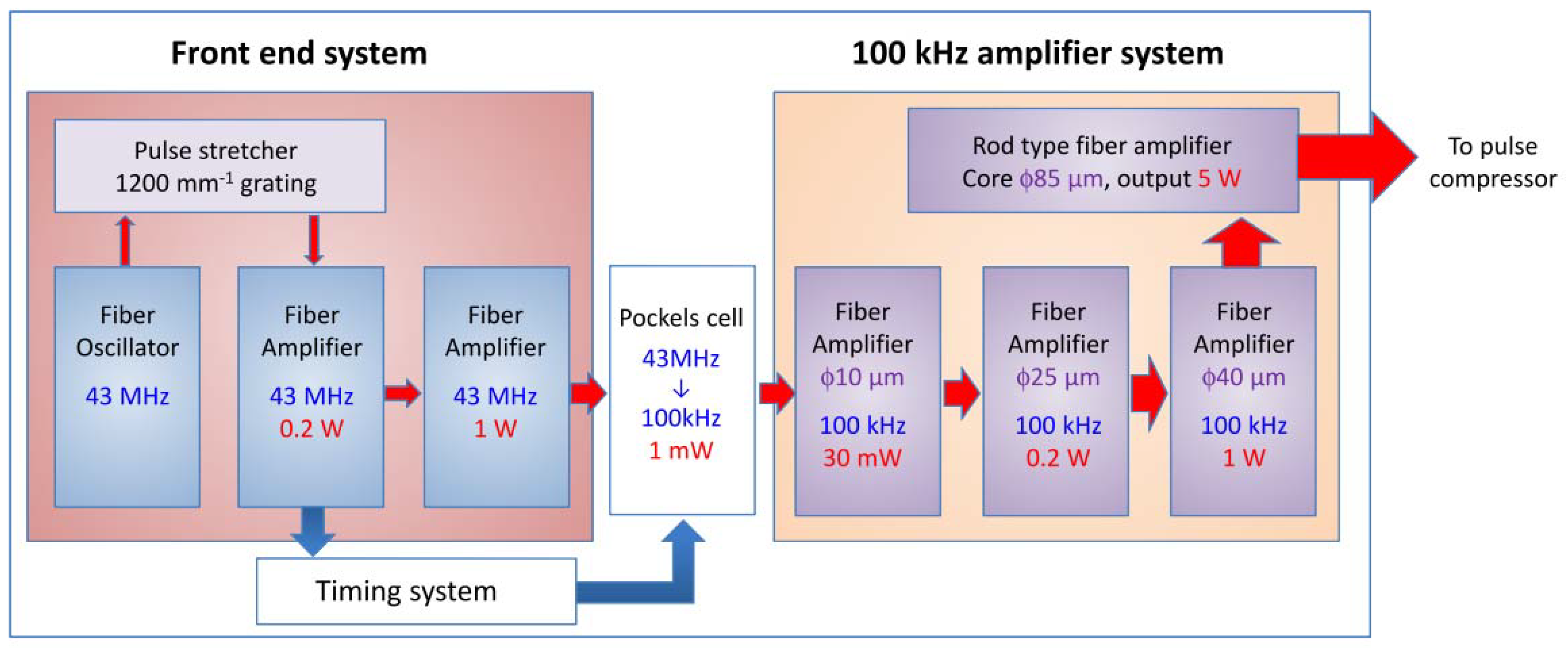

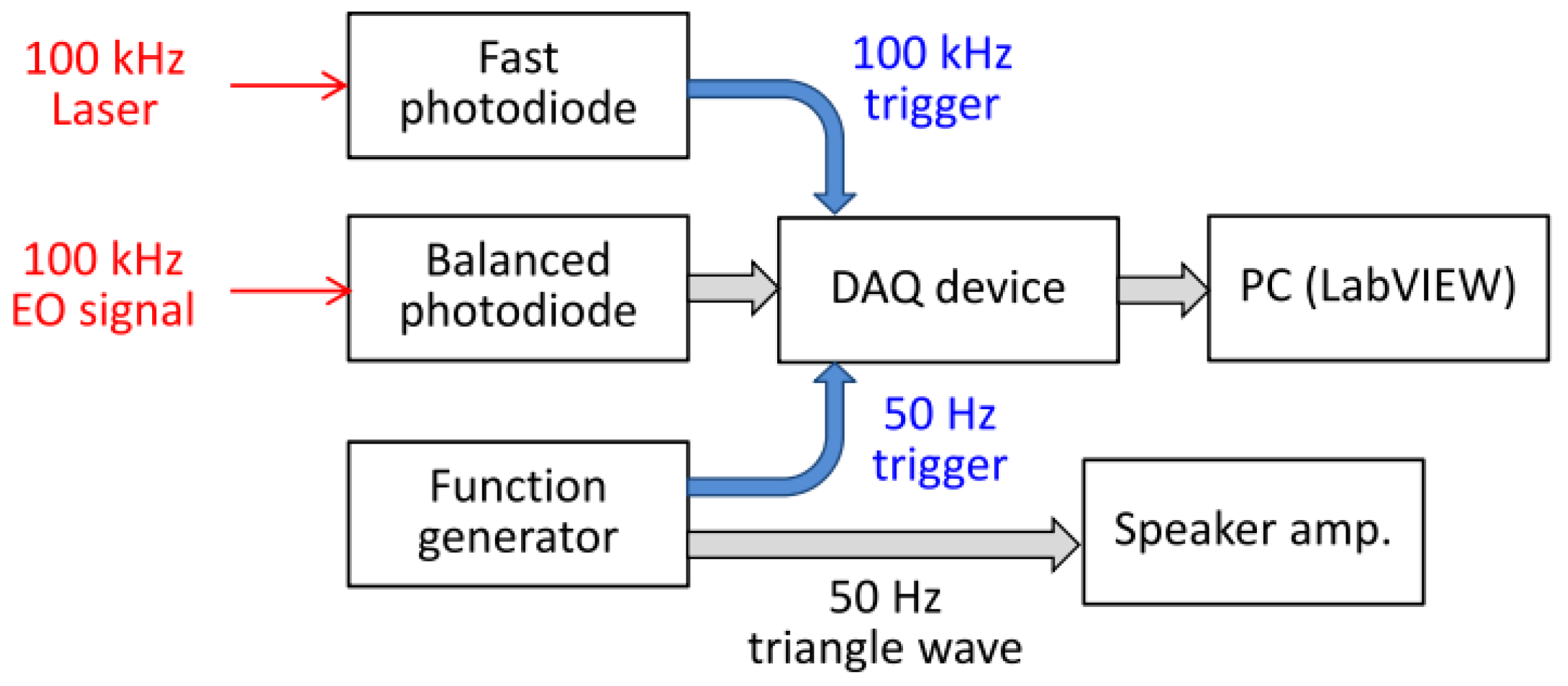
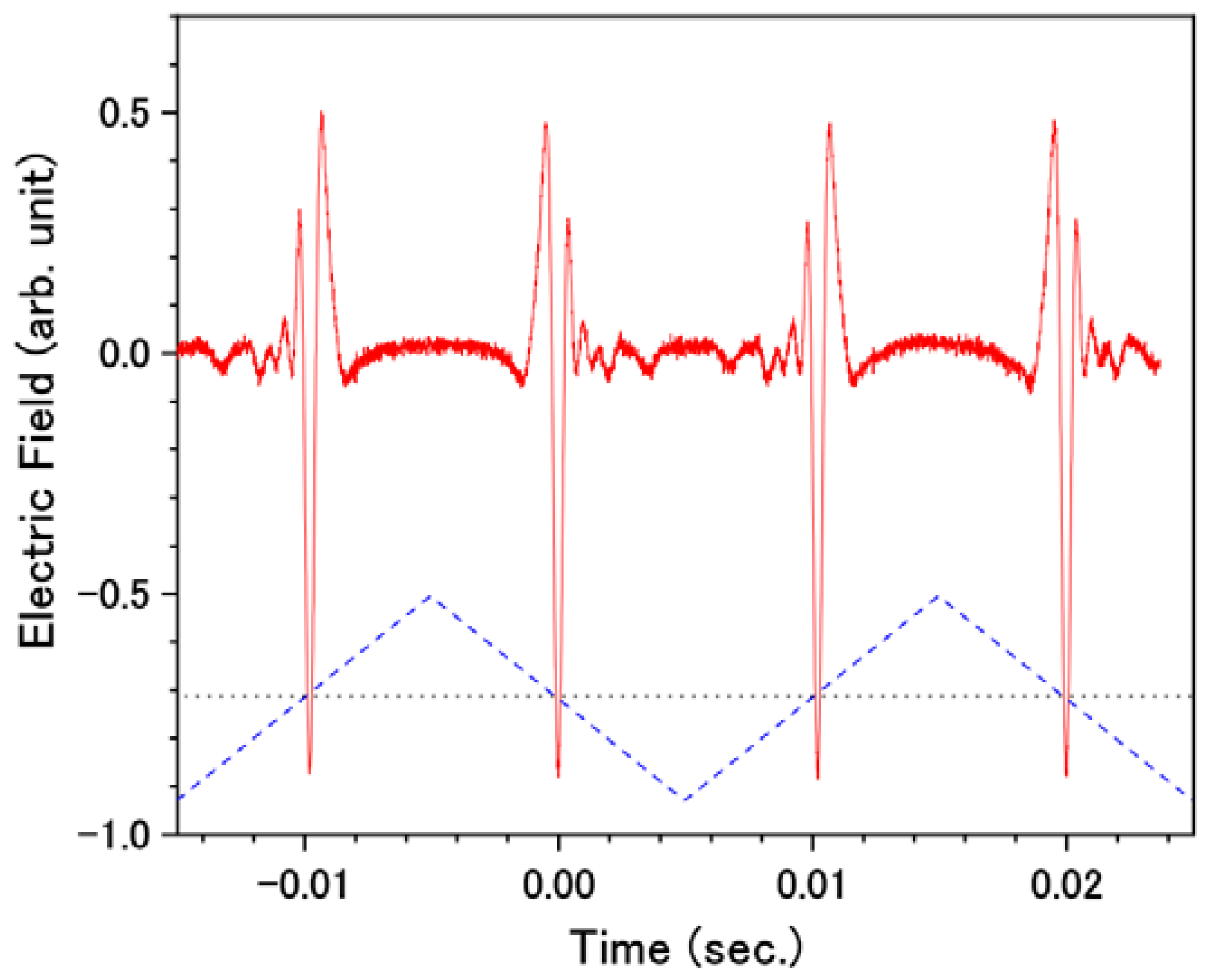
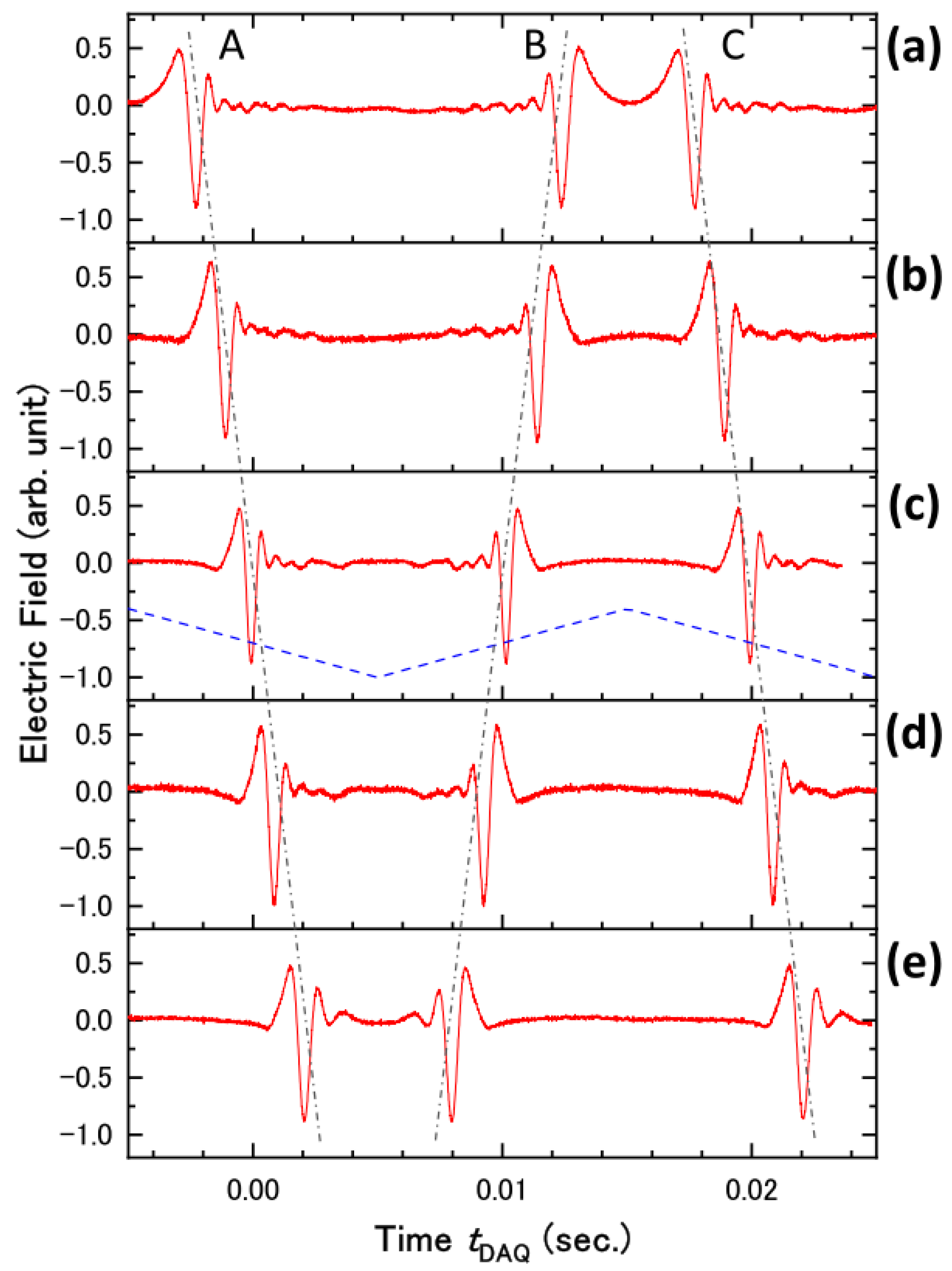
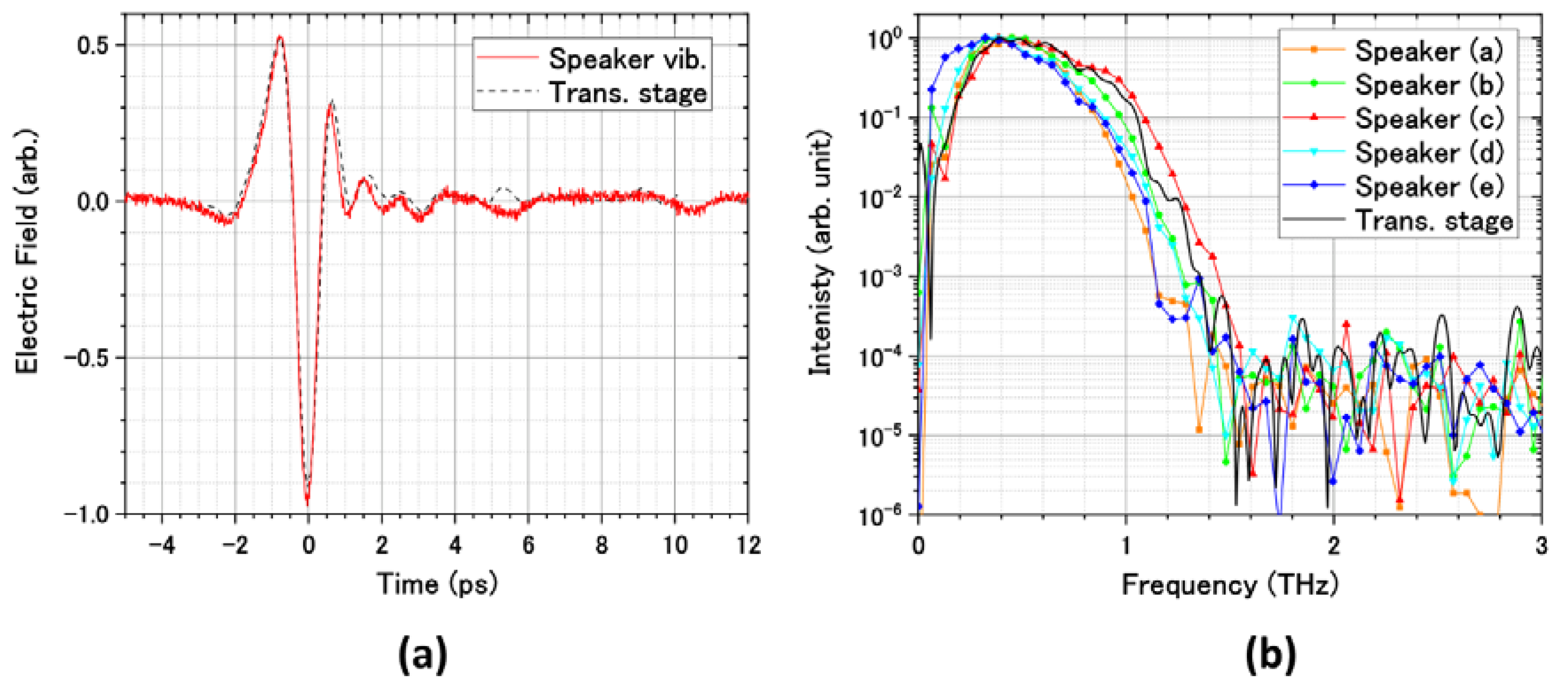
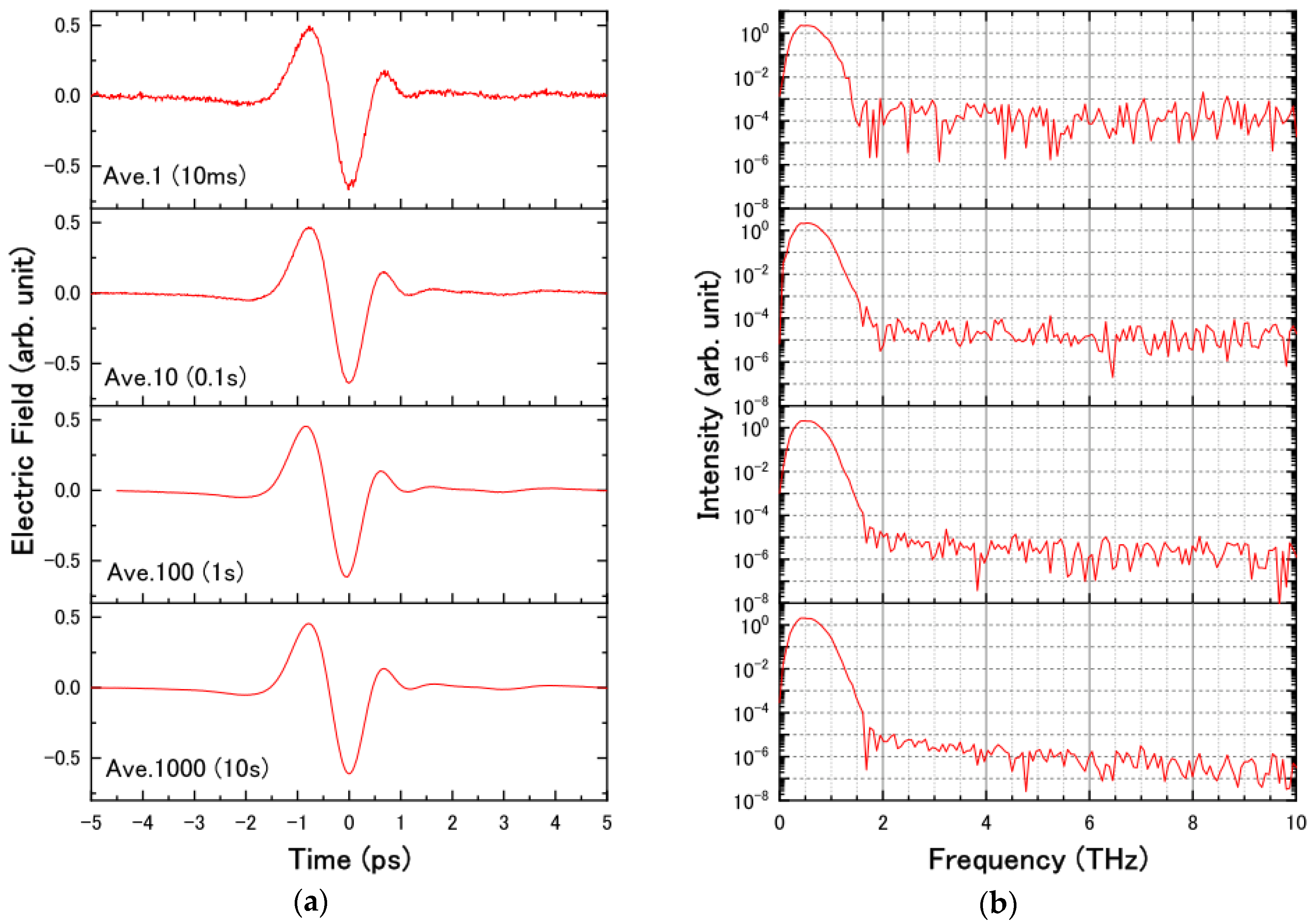
© 2018 by the authors. Licensee MDPI, Basel, Switzerland. This article is an open access article distributed under the terms and conditions of the Creative Commons Attribution (CC BY) license (http://creativecommons.org/licenses/by/4.0/).
Share and Cite
Tsubouchi, M.; Nagashima, K. High-Speed Terahertz Waveform Measurement for Intense Terahertz Light Using 100-kHz Yb-Doped Fiber Laser. Sensors 2018, 18, 1936. https://doi.org/10.3390/s18061936
Tsubouchi M, Nagashima K. High-Speed Terahertz Waveform Measurement for Intense Terahertz Light Using 100-kHz Yb-Doped Fiber Laser. Sensors. 2018; 18(6):1936. https://doi.org/10.3390/s18061936
Chicago/Turabian StyleTsubouchi, Masaaki, and Keisuke Nagashima. 2018. "High-Speed Terahertz Waveform Measurement for Intense Terahertz Light Using 100-kHz Yb-Doped Fiber Laser" Sensors 18, no. 6: 1936. https://doi.org/10.3390/s18061936
APA StyleTsubouchi, M., & Nagashima, K. (2018). High-Speed Terahertz Waveform Measurement for Intense Terahertz Light Using 100-kHz Yb-Doped Fiber Laser. Sensors, 18(6), 1936. https://doi.org/10.3390/s18061936




